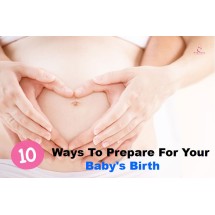
When the pregnancy reaches the expected due date, parents tend to get anxious and excited about the baby’s arrival. When the baby is ‘late’, it is tempting to induce labour.
This is generally not recommended without discussing with your doctor and more importantly, one has to be mindful that the expected due date may be wrong. It is an estimate and given the many developments that are happening to your baby in the last few weeks of pregnancy, inducing labour that results in a premature birth carries many risks and complications. Many mothers prefer to give the baby a little ‘push’ so that they will give birth naturally. This usually happened when it is one to two weeks past their due date.
If you were wondering if there are natural ways to meet your little one, you got to try at least one of these safe and natural methods below! Come on, bring on the labour!

#1 Nipple stimulation
Nipple stimulation refers to massaging the nipples, including the areola one at a time for about five minutes. This is to stimulate the production of oxytocin, the hormone that trigger contractions and initiate the milk let-down response. As this can be quite effective in some mothers, it is best to wait for 15 minutes to see if there are any contractions before continuing. Do not take nipple stimulation lightly and overdo.
#2 Acupuncture
Acupuncture is another method that has been reported to be effective and it may take one to three acupuncture sessions for it to work. Proponents of acupuncture cite that the needling encourages the mother’s body to naturally release the hormone prostaglandin that soften and ripen the cervix. Acupuncture also helps the mother’s body to increase its hormone oxytocin to trigger contractions. As such, it is considered ‘natural’ because it works by stimulating the mother’s body to release its own hormones rather than medically introducing these hormones.
#3 Acupressure
Acupressure is massage that focuses on acupressure points that will help to trigger labour. It is also meant to be relaxing for the mother, with the use of essential oil that is believed to help induce labour. Its objective is to ‘remove the block’ from various body parts to help the mother’s body start to prepare for labour.
#4 Evening primrose oil

Credits to iherb
Evening primrose oil contains linolenic acid, gamma linolenic acid and vitamin E. The linolenic acid may trigger the release of hormone prostaglandin that can ripen the cervix. It is taken orally or the capsule is inserted directly into the cervix. Do check on the dosage and when to start on evening primrose oil (around 37-39 weeks). Not all the studies on the use of evening primrose oil are positive, so it is best to check with your doctor.
#5 Date fruit
The consumption of date fruit has been linked to lower incidence of medical induction, and a wider cervical dilation upon hospital admission. It is also associated with reduced time for the first stage of labour. The intake of date fruits starts from about four weeks before the expected due date, with about six date fruits per day. However, similar to many of the foods that are believed to induce labour, excessive intake will upset the stomach.
#6 Pineapple
Pineapple contains an enzyme bromelain that is believed to be able to ripen the cervix and start labour. Eating too much of pineapple can cause diarrhea and may lead to heart burn. Papaya also contains bromelain.
#7 Curry
Though this is not proven, many mothers believe that eating spicy curry will get the labour going. For those who normally don’t eat curry, you may not want to try this as it may lead to stomach upset. Moreover, certain spice stimulate capsasins that are studied to reduce the effects of endorphins, thus making labour more painful.
#8 Exercise
Exercise such as a long walk or stair climbing is also believed to get the labour started. It may be partly due to gravity, where the pressure from the baby helps to dilate the cervix. This is quite safe as long as the exercise is not intensive nor too exhausting as you don’t want to go into labour already tired! A long relaxing walk with your spouse is healthy and stress-relieving.
#9 Sex
If you are in the mood for sex during the last few weeks of pregnancy, it is a method to bring on labour as it stimulates the release of oxytocin and the semen also has high concentration of prostaglandin that can help the cervix to contract. The ejaculation has to be inside the vagina for it to help with the dilation and ripening of the cervix. Do check with the doctor as sex is not recommended if there is vaginal bleeding or a low-lying placenta.
#10 Raspberry leaf tea
Midwives often recommend drinking red raspberry leaf tea as the tea is believed to help tone the uterus and regulate contractions into regular patterns.
Do remember that natural ways to induce labour are not well researched and may not work well, if at all. Certain foods such as castor oil can cause severe diarrhea, risking dehydration. Inducing labour may lead to birth requiring interventions (epidural, assisted or caesarean births) as the mother’s body and baby are not ready. Check with your doctor, and this is critical if you have a pre-existing health or pregnancy condition.









